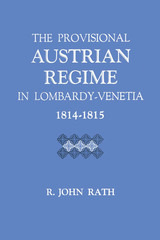
When Austrian soldiers first set foot in Lombardy-Venetia in October, 1813, they were greeted everywhere as liberators and friends. In the spring of 1815, when Joachim Murat's efforts to establish a united Italy ended in miserable failure and when the Habsburgs announced the main features of the regime they intended to establish in their Italian provinces, the Venetians were still strongly pro-Austrian, but considerable anti-Habsburg feeling had developed among the Lombards.
This carefully documented study of the first two years of Austrian reoccupation of Lombardy-Venetia examines all aspects of the Habsburg provisional regimes and draws some conclusions about the reasons for the different attitudes in the two provinces. In detailed sketches of the provisional governments of Venetia (Chapter I) and Lombardy (Chapter II) and an examination of Austrian economic policies and practices in both provinces (Chapter III), the author shows that although the governments of the two provinces shared many common traits, they differed in a number of significant ways. Actually, Venetia was much less efficiently governed than Lombardy; and the Lombards enjoyed at least a small measure of self-administration that was largely denied the Venetians. The Lombards were much more prosperous than their neighbors, yet they paid much less in taxes and were exempt from most of the burdensome military requisitions that the Austrians inflicted on the Venetians. In spite of these advantages, the relatively small nationalist movement in Austria's Italian provinces was almost entirely confined to Lombardy.
The author examines public opinion in Lombardy-Venetia about liberal intrigues (Chapter IV); the relationship of secret societies to liberalism (Chapter V); the Brescian-Milanese conspiracy (Chapter VI) and the Austrian handling of that affair (Chapter VII); and the fiasco of Joachim Murat's "War of Italian Independence" (Chapter VIII).

Liberalism, in the nineteenth-century sense of the term, came to Austria much later than it came to western Europe, for it was not until the 1840s that the industrial revolution reached the Hapsburg Empire, bringing in its train miserable working conditions and economic upheaval, which created bitter resentment among the working classes and a longing for a Utopia that would cure the ills of mankind.
This new-found liberalism, largely self-contained and uninfluenced by liberal movements outside the empire, centered mainly in the idea of individual freedom and constitutional monarchism. In the end, the revolution failed because the moderates proved too weak to control the radical excesses, and the radicals in growing desperation tried to turn the rebel idea into a democratic and, at the extreme, a republican one. Fear of this extremism finally drove the moderates into the counterrevolutionary camp.
Since the Viennese rebels fought to achieve many of the goals fundamental to democracy, historians have generally tended to idealize the revolutionaries and forget their shortcomings. R. John Rath has sought to evaluate the revolution from the point of view of the political ideologies of 1848 rather than those of the mid-twentieth century. Moreover, he has clearly and objectively stated the case for both the left and the right, pointing out the failures and shortcomings of each.
At its publication, this was the first detailed English-language book on the Viennese Revolution of 1848 in more than a hundred years. The author has not confined himself to the bare bones of history. In his descriptions of the times and lively portrayals of the chief actors of the revolution, he has vividly restaged a drama of an ideal that failed.
READERS
Browse our collection.
PUBLISHERS
See BiblioVault's publisher services.
STUDENT SERVICES
Files for college accessibility offices.
UChicago Accessibility Resources
home | accessibility | search | about | contact us
BiblioVault ® 2001 - 2024
The University of Chicago Press









